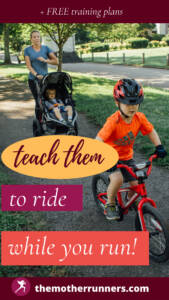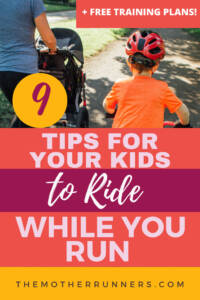I’ve written a lot about how to run with a stroller but what about when your kids get older? Then it’s time to talk about how to teach your kid to run a bike while you run.
Having your child ride a bike next to you on your runs is a wonderful bonding activity and is another way to teach them the value of being active, living healthy, and being outdoors. But, it can be tricky. Perhaps, they don’t want to go and there is pushback. Maybe they can’t go very far. Or, what if they go too fast or too slow?
In this post, I am going to over the very basics of how to teach your kid to ride a bike and then detail how to teach them to ride a bike while you run. A lot of the skills you homed in stroller running come in handy here: start slow and short, take lots of breaks, be patient, and HAVE FUN. Oh, and sometimes bribery—I mean REWARDS—come in handy.
Related: 12 Genius Tips for Stroller Running
But first, let’s get some general information about how to teach your kid how to ride a bike out of the way:
When can my child start riding a bike?

Most kids start to ride a bike around age four. At this age, they have the balance, leg strength, coordination, and understanding to begin riding a bike starting with training wheels and/or a balance bike.
However, if your kid is frustrated or doesn’t have an interest at this age. Do not worry and DO NOT force it. Wait. And, try again when they seem more interested.
How can I tell if my child is ready to ride a bike?
If your child shows that they are interested in riding a bike, then they are likely ready. This typically happens between age 2, all the way up to age 8.
Many kids start with a tricycle and/or balance bike around age 2. Around age 5 or so, they may be ready to progress to a two-wheeler.
Once your child is comfortable on a balance bike or on a bike with training wheels pedaling, you can try transitioning them to a two-wheeler.
What is the best age to teach a child to ride a bike?
You can start introducing a balance bike or tricycle around the age of 2. You can likely begin introducing riding a two-wheel bike around the age of 5.
However, kids develop mentally and physically at different rates so if your child doesn’t have an interest in learning how to ride a bike or can’t push the pedals, that’s okay. Take a break and try again.
Related: How to Teach Your Kids to Start Running
How do you teach a reluctant child to ride a bike?
If your child doesn’t want to ride a bike, don’t force it. Back off and then talk to them about what is frustrating them and what seems difficult. Stay positive. Don’t have deadlines. Don’t apply pressure. And, keep at it. Perhaps have a goal to try every weekend. Reward their efforts.
Learning how to ride a bike does take practice and (like running) consistency will make a big difference. Once they learn how to push the pedals correctly and/or balance, you’ll see a sharp incline in their confidence on the bike.
How long does it take to teach my child to ride a bike?
There is no set timeline for how long it will take your child to learn how to ride a bike. For some kids, it happens quickly. For others it can take weeks.
My daughter learned on her first try. It took my son more than a month.
Staying consistent and positive is the most important tact when it comes to teaching your kid how to ride a bike.
Related: 7 Science-backed Reasons Running Makes You a Better Mom
How do I get my kid to stop using training wheels?
The best way to teach your kid to ride without training wheels is to take the pedals off along with the training wheels—essentially turning your two-wheeler into a balance bike.
Lower the seat and make sure your child can touch the ground. Get them comfortable moving with both feet at a time—pushing and gliding. Play games and see if they can glide for 10 seconds at a time.
Once they feel comfortable doing that, you can put the pedals back on and have them practice putting together the two skills they already know: how to pedal (learned while using training wheels) and balance (while on the balance bike).
Here are some tips:
- Hold the back of the bike seat.
- Have you child start pedalling.
- Make sure they look ahead and not at the ground.
- Run alongside them until they are balanced and moving steadily.
- Then let go.
- If they fall, tell them it’s okay! That’s normal! And try again.
What are good bikes for children?
We like the Y Velo balance bikes for starter bikes and the Royal Baby bikes for training wheel bikes and two-wheeler bikes. They come in cool, vibrant colors; are easy to assemble; and are pretty well-made.
How to teach your child to ride a bike while you run
I spoke with many mother runners who have their kids ride their bikes next to them while they run. Here are their best tips to teach your kid to ride while you run!
9 Tips to Teach Your Kids to Ride a Bike While You Run

-
Get the right gear.
First thing’s first, make sure your kids have the proper bicycling gear. Make sure the bike is an appropriate fit, the seat is at the right height, and the helmet is snug against their head.
Your child’s helmet should not wobble and there should be only two finger widths of space between your child’s eyebrows and the brim. The straps should tight so that you fit only two fingers between the strap and chin.
Elbow and knee pads are useful for beginners who may tumble a lot.
-
Start in a clear area.
Practice riding a bike while you run in a clear area that doesn’t have a lot of cars. An empty parking lot or running track where you can do loops is a perfect location for your child to get comfortable riding a bike while you run.
-
Practice steering, slowing, and stopping.
Once your child is confident coasting and pedaling on their bike, it’s time to throw in some drills. You can do obstacle courses with cones to have them practice turns. Play red light/green light to have them practice slowing and stopping.
You can even role play running together and encountering obstacles that involve turning and stopping abruptly.
-
Start on a greenway.
It’s recommended you start running with your child on a bike on a greenway so you don’t have to worry about cars. This way they become proficient learning how to pace with you and what to do if there are obstacles or moments needing quick decisions.
-
Give rules.
It’s very important to lay ground rules before you and your child venture out riding for real on the roads.
Some example rules include:
- Children must always stay to the right as they ride.
- Children must always ensure they can see their parents.
- Children must not ride their bikes too far ahead.
- Children must always stop and wait for their parents at intersections, stop signs, and traffic lights.
- Children must know the route before riding as their parents run.
- Make sure your kids know what to do if they get ahead of you, if there is an oncoming car, or a turn.
-
Start short and go slow.
Just like with running with a stroller, check your expectations at the door. Start with a short distance such as around the block. And, go slow.
The goal is for your child to get used to riding with you as you run—and for you to get a rhythm for one another. You may run faster than they ride and vice versa—all in the same outing. Don’t expect to run 5 miles in your first run/ride.
Related: How Cold is Too Cold for a Stroller Run?
-
Take breaks.
Also similar to stroller rides, take lots of breaks, as needed. One mom likes to pack a bag that rides with one of her daughters full of snacks for her girls to have a picnic mid-run. This tactic works so well, she regularly runs 8 miles while her daughters rides next to her.
Other moms like to stop at parks and playgrounds along the way.
-
Incentivize.
Bribery. Rewards. Incentives. Call it what you may, but they are a powerful tool in making your runs/rides with your kids happen.
Give your kids a special treat after they ride their bikes with you, allow them to watch some of their favorite show after, or take them to one of their favorite places. One mom runs to the pump track so her kids have a destination they’re really excited about in the journey.
-
Stay positive and have fun.
Being able to run while your kids ride their bikes is a special time that holds the opportunity to strengthen your relationship with your kids and teach them healthy habits that will last a lifetime.
So, stay positive if things don’t go according to plan: If your kid falls, skins his knee before you even get started and refuses to keep going, that’s okay. Stay positive! If you keep at it, you two will get into a flow that will make life so much easier and richer in the long run!
If you want help with your running goals as a mother runner, check out my run coaching services!
